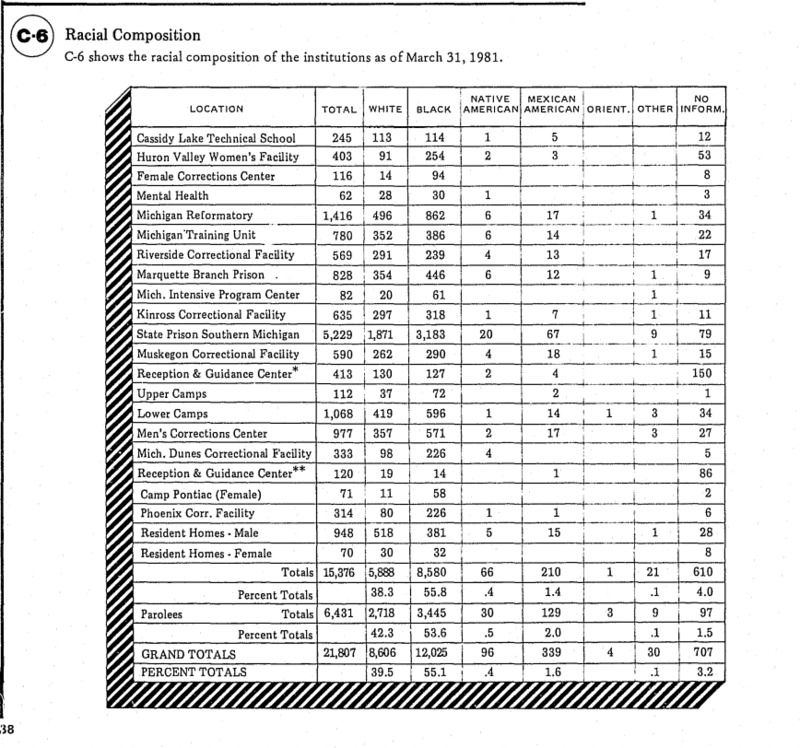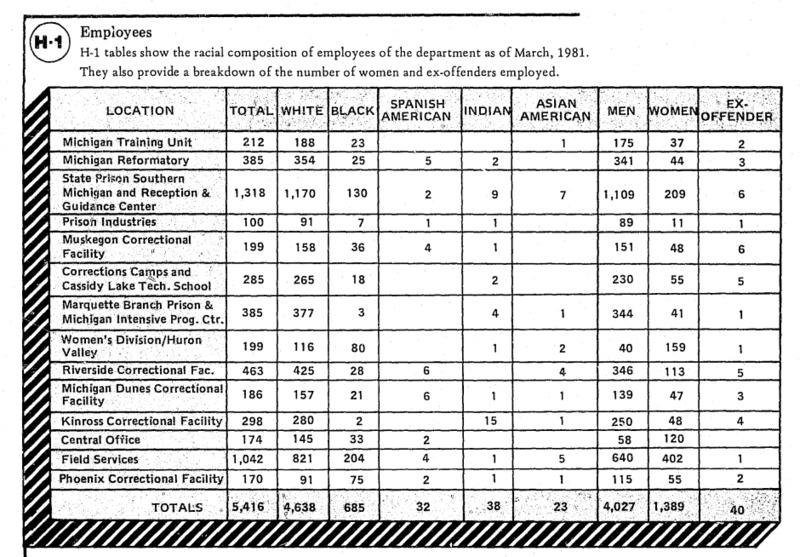Demographics
As of March 31, 1981, SPSM had a total inmate population of 5,229 individuals. This was a marked increase over 11 years from 4,139 inmates in 1970. Of these inmates, 3,183 (60.87%) identified as Black, 1,871 (35.78%) as white, 20 (0.38%) as Native American, 67 (1.3%) as Mexican American, and 88 (1.7%) as other/no information. It is clear from these statistics that the largest minority group within SPSM was those who identified as Black. Given the hyper-criminalization and systemic over-policing of Black communities especially in Detroit, this is no surprise. Not only do these statistics speak to these issues as well as the racialized nature of mass incarceration, but they also lead us to further question the racial demographics that the US Census takes, both then and now, of Jackson. Since Black men were and continue to be so disproportionately incarcerated, counting them as residents of the prisons in which they are confined in skews Census data to make rural, predominantly white counties like Jackson appear more diverse. This pulls attention, resources, and political representation away from true minority neighborhoods and diverts it towards the counties that house these prisons. We explore this issue in conjunction with Jackson's legacy further on our prison gerrymandering page.
In addition to being racially discriminatory, the sheer number of inmates housed in Jackson Prison as a result of mass incarceration was indicative of a persistent overcrowding issue. In an effort to address the crisis, The Prison Overcrowding Emergency Power Act was passed by the Michigan Legislature and approved by Governor Blanchard. It allowed minimum sentences to be rolled back by at most 90 days for good behavior to alleviate the issue of overcrowding in facilities across Michigan, but especially at SPSM. In October 1981, Ingham County Circuit Court Judge Ray Hotchkiss placed a ceiling on the number of inmates that Michigan could accept into its corrections system in response to a lawsuit that alleged that overcrowding amounted to “cruel and unusual punishment” prohibited by the Eighth Amendment. The court order “fixed” the system’s capacity and required that each department phase out temporary housing by 1984. In order to meet these “fixed” capacities, the Jackson prison would have to significantly reduce its prison population to 5,173.
In addition to reducing the prison population, the order also mandated that each inmate be provided with a single cell or at least 60 square feet per person in community housing, as well as one toilet for every 8 people and one shower for every 15 individuals. This order also required the Michigan DOC to slightly liberalize its' parole policy and increase its use of community residential programming. If overcrowding continued to be an issue, then the order allowed the DOC to transfer newly arriving inmates to county jails. In order to make these improvements and potentially alleviate the issue of overcrowding, the DOC required millions of dollars, which it was at a loss of how to obtain. One possible solution was offering a referendum to the Michigan public to create four new regional prisons to alleviate inmate population pressures in pre-existing prisons by increasing the income tax by less than 1%. This proposal was put forth on the November 4th ballot and was soundly rejected by voters. The rejection of the funding proposal combined with the court's decision to limit prison capacity made the DOC desperate for solutions to fix the obvious issue of overcrowding, despite few successful attempts to actually address how these issues played out in the lives of the inmates themselves.
Completely overcrowded, the inmates at SPSM were also failed by the Michigan DOC whose employees and correctional officers were wholly unrepresentative of the populations that they were working with. The guards were almost all white, while the populations that they patrolled were majority Black. As of March 1981, 1,318 guards were employed at SPSM, with 1,170 of those guards identifying as white. Only 130 guards identified as Black and 2 as Spanish American, the two largest minority groups for inmates. In addition to being racially unrepresentative of the inmate population that they were protecting and controlling, only 6 guards were ex-offenders themselves. This meant that overall, the guard population at SPSM had no context for the kind of treatments that they were dispensing or the kinds of trauma that the inmates were experiencing, especially in an acutely overcrowded prison like SPSM. A completely unrepresentative guard population would have most likely made it more difficult for the guards to empathize, or even humanize, with the inmates that they were patrolling. A dangerous “Us vs. Them” mentality for the guards and inmates alike may have been brewing, only contributing further to the animosity within SPSM that eventually manifested into a riot.
Sources:
Corrections Commission. Michigan Department of Corrections 1980 Statistical Presentation. Michigan Department of Corrections, 1981.



